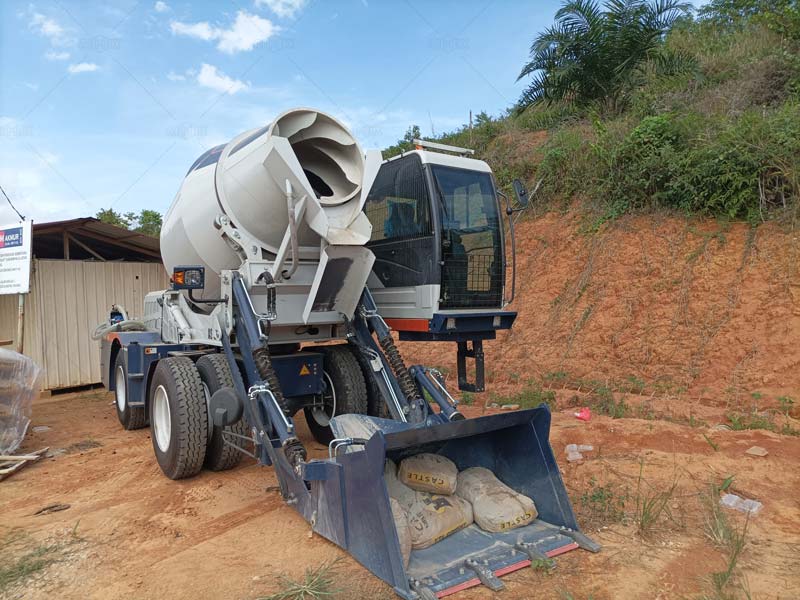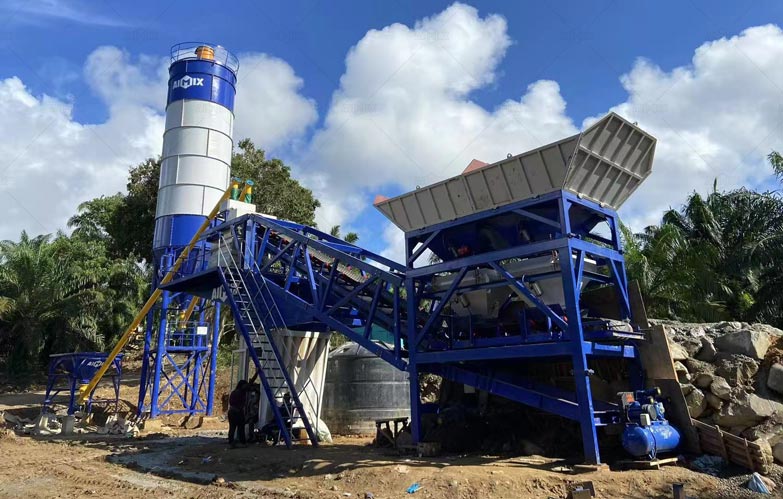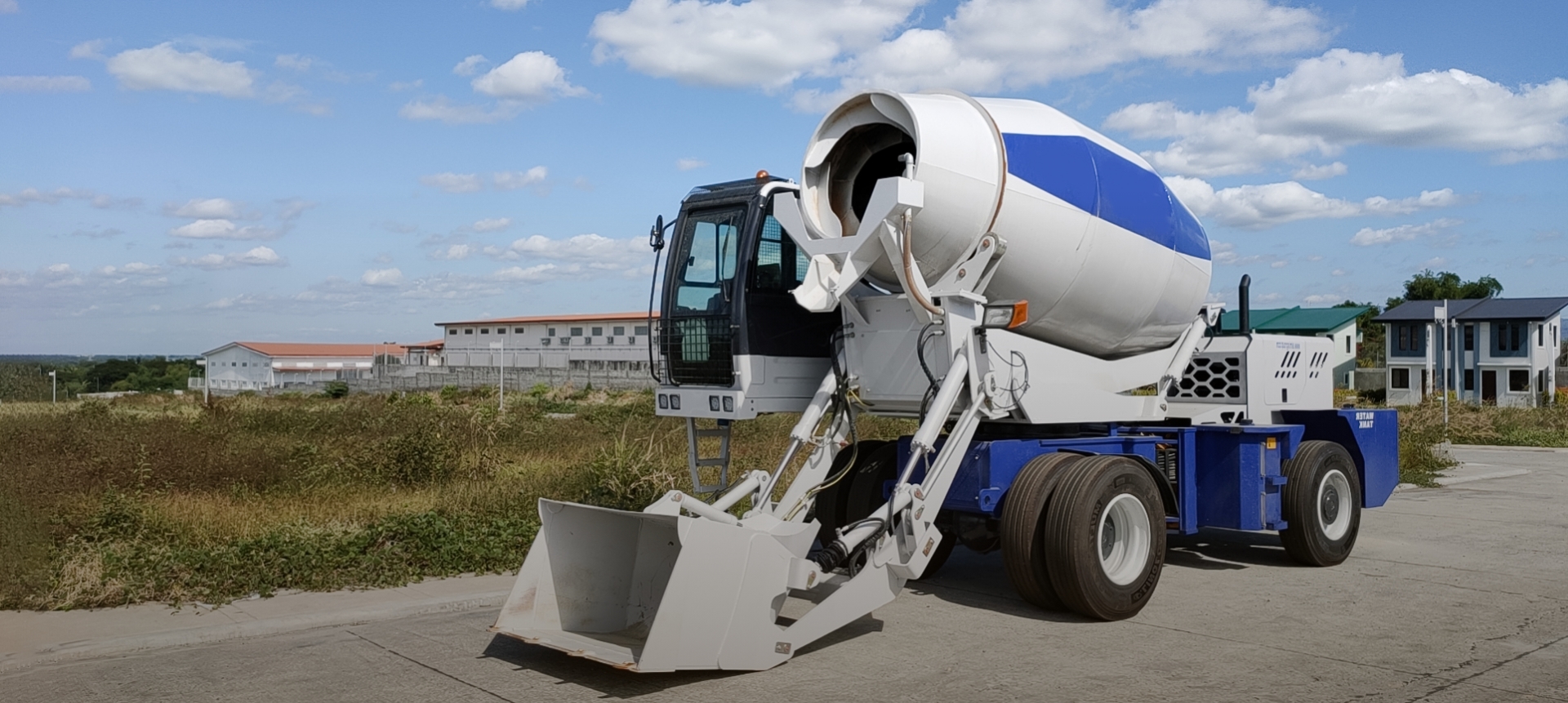Choosing the right equipment for mobile concrete production is critical for ensuring productivity, cost-efficiency, and concrete quality. Both self-loading concrete mixers and mobile concrete plants are designed for flexible, on-site operations, but they serve different needs depending on project scale, terrain, labor, and automation requirements. This article breaks down the major differences between the two, helping contractors and project managers make informed decisions for mobile construction scenarios.
Overview of Self-Loading Concrete Mixers
What Is a Self-Loading Concrete Mixer?
A self-loading concrete mixer(auto hormigonera) is a compact machine that combines the functions of a wheel loader, concrete mixer, and water tanker into a single vehicle. It is capable of self-loading raw materials, weighing them using an intelligent system, mixing concrete on-site, and transporting it directly to the point of use.
Key Features
- One-person operation with automatic weighing and mixing
- On-site mobility and 4WD off-road capability
- Built-in water system and high-definition control panel
- Capacity typically ranges from 1.2 m³ to 6.5 m³ per batch
Who Should Consider It?
If you’re working on small to mid-size construction projects in remote or uneven terrain, a self-loading concrete mixer offers unmatched flexibility. It’s especially effective for contractors dealing with frequent site changes or limited access to traditional batching equipment.

Overview of Mobile Concrete Plants
What Is a Mobile Concrete Plant?
A mobile concrete plant(planta de concreto movil) is a portable version of a stationary batching plant. It includes aggregate bins, a cement silo, conveyor systems, a weighing system, and a twin-shaft or planetary mixer. Though it requires installation at the site, it offers higher capacity and automation for continuous concrete production.
Key Features
- Higher output capacity (from 25 m³/h to over 90 m³/h)
- Automated batching control and recipe management
- Modular design for faster installation and relocation
- Separate mixer and loader systems
Who Should Consider It?
A mobile concrete plant is ideal for large-scale or long-term projects requiring consistent concrete supply. It is preferred by developers of infrastructure, roadworks, bridges, and housing complexes where high volumes and production speed matter.

Key Differences in Mobile Operations
1. Mobility and Site Adaptability
The self-loading concrete mixer is fully mobile and requires no site preparation. It can drive across rough terrain, making it suitable for remote and uneven job sites. In contrast, a mobile concrete plant, while portable, needs flat ground, crane assistance, and partial assembly before use.
2. Labor and Operation
A self-loading concrete mixer is designed for one-person operation. The driver loads, mixes, and transports concrete directly. On the other hand, a mobile concrete plant requires multiple workers—loader operators, batching control technicians, and sometimes an electrician for setup.
3. Output Capacity
Self-loading mixers are best for low to medium-volume needs, typically producing 10–30 m³ of concrete per day depending on model size. Mobile concrete plants can produce 25–100+ m³ per hour, making them better suited for high-output demands.
4. Accuracy and Automation
Modern self-loading concrete mixers come with intelligent weighing systems and programmable mix settings, offering ±2% accuracy. However, mobile plants use more advanced computerized batching systems that allow for precise mix design control and continuous production.
5. Cost and Investment
The self-loading concrete mixer price(hormigonera autocargable precio Bolivia) is generally more affordable, especially for small contractors. Depending on the model and configuration, prices range from $15,000 to $60,000. In contrast, a mobile concrete plant is a bigger investment, ranging from $60,000 to $150,000 or more.
6. Transportation and Installation Time
Self-loading mixers are ready to work upon delivery with zero setup time. Mobile plants may require 2–5 days for installation and calibration before operation begins. This can be a deciding factor in urgent or fast-moving projects.
Market Considerations and Availability
For buyers looking for flexible, low-cost solutions, there are many options of self-loading concrete mixer for sale(venta de autohormigonera Paraguay) through international suppliers and local dealers. Latin America, Southeast Asia, and Africa are seeing a rise in adoption due to the machine’s self-sufficiency in regions with poor infrastructure.
In contrast, demand for mobile concrete plant solutions is increasing in regions with growing construction sectors and government-backed infrastructure programs. The choice between the two often comes down to project size, terrain, and labor availability.
Choosing the Right Equipment for Your Needs
If your job site changes frequently or involves challenging terrain, a self-loading concrete mixer offers unbeatable efficiency and mobility. For continuous concrete supply on a fixed site with high volume demands, a mobile concrete plant is the better long-term solution.
Contractors should also consider the self-loading concrete mixer price versus the productivity and labor savings it offers. When scaled properly to the project size, both solutions can deliver excellent returns on investment.
Conclusion
While both self-loading concrete mixers and mobile concrete plants are designed for mobile operations, their differences in mobility, capacity, labor needs, and cost make them suitable for very different types of projects. Understanding these distinctions helps construction professionals choose the right tool for the job—whether it’s a small rural site or a major infrastructure project. Whichever solution you choose, investing in mobility ensures greater flexibility and responsiveness in a fast-paced construction environment.
